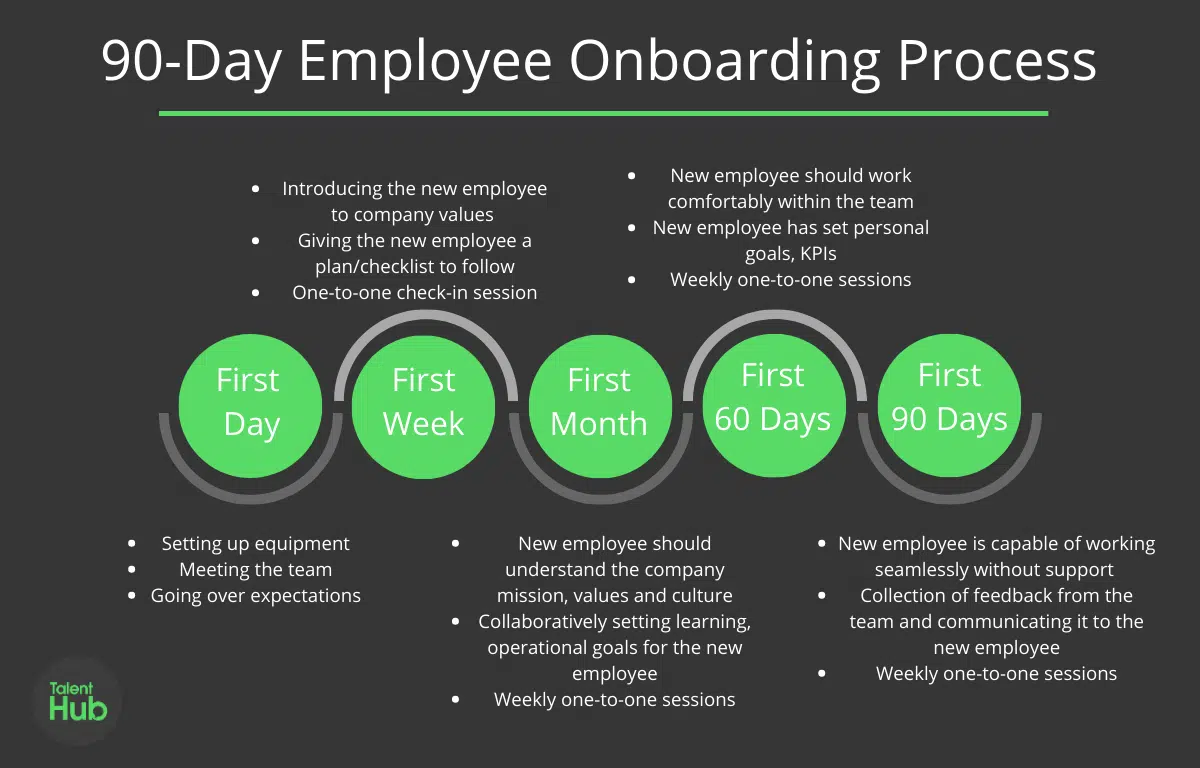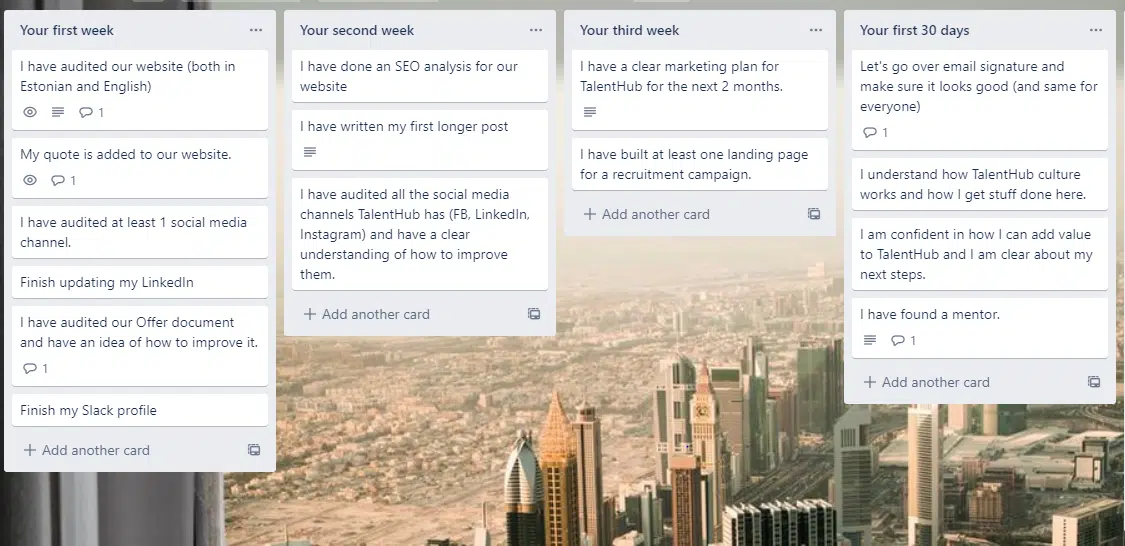How To Onboard A Employee (90-Day Process Guide)
Having a structured onboarding process within the company plays a key role in retaining employees. According to research, employees who feel their onboarding process was effective are 29 times more likely to feel satisfied at work.
Employee Onboarding Meaning
Onboarding is the strategic process of introducing a new employee to the organization. An employee onboarding can last anywhere from a few months up to a year.
What makes for a successful onboarding process?
The purpose of onboarding is to successfully integrate a new employee into the company by giving them the tools and information needed to become a productive member of the team.
Ideally, by the end of the onboarding process, you want the new employee to feel confident and competent in their role.
Common myths about onboarding
Myth #1: You only need to onboard junior employees
One of the biggest myths around onboarding is that companies believe they only need to onboard junior employees who are inexperienced. That is not the case. Actually, senior employees need an even more thorough onboarding plan. This is because employees in senior roles have more responsibility and a bigger impact on the company.
By the end of the onboarding process, if a senior employee doesn’t know their purpose in the company, or doesn’t have a clue about what they are doing, it could end up being a disaster.
So remember, no matter the seniority of the employee, having an onboarding plan in place is crucial.
Myth #2: Onboarding is an individual effort
Yes, there needs to be an individual person that is responsible for the onboarding process. But that doesn’t mean that the rest of the team shouldn’t be involved.
A successful onboarding process requires team effort. To make the new employee feel comfortable, the whole team should make a conscious effort to support them.
Pro tip: Make sure you get your team involved in the onboarding process. Let them know how they can help out!.
Myth #3: Onboarding starts on the employee’s first day on the job
Oftentimes, companies think that onboarding starts from the day the employee steps their foot into the office. But actually, onboarding already starts from the day you offer the candidate the role.
There’s usually a time between when the contract is signed and when the employee actually starts. So, instead of letting the employee wait for their first day, think about ways you can make them already feel more included. Could they read something before they start? Could you invite them to lunch with their new team? Get creative!
We also recommend you send your new employee a welcome email that includes a schedule of what’s going to happen during their first day. This is good for not only bringing clarity, but also calming some nerves.
Remember, small gestures like this will make the new employee feel more welcome, and even more excited about starting their new role!
New Hire Onboarding Checklist
First Day
The first day of the employee’s job should not be filled with complicated work. Chances are they are already overwhelmed with being in a new environment.
Instead, the first day should have three goals: setting up the necessary equipment, meeting the team, and going over the expectations.
Setting up equipment: Make sure the employee has all the necessary tools to start working at the company. This could be providing them with the right technical equipment, as well as giving access to communication tools and setting up accounts.
Meeting the team: You should also ensure the employee has a chance to meet the team on their first day. This could be done by organizing a team lunch, for example. Also, we recommend you assign the new employee a buddy – someone who they can always go to whenever they have any questions or concerns.
Going over expectations: The first meeting you have should be about setting expectations. It is important for the new employee to understand what they can expect from their onboarding, how the team works and what are the working hours. But employees also want to know when and if they are doing a good job. That is why it is important for you to have expectations for them. If you are a startup, it is okay if you don’t have any specific expectations, but you should at least give them a direction to strive towards.
First Week
Once you have gone over the expectations, and given the new employee an idea of how they can be successful, you should give them a plan they can follow. The plan can be in different formats e.g goals, smaller tasks or general expectations. For example, if your new employee is a project manager, you can set a goal for them to get familiar with one project by the end of their first week. Or, if you are onboarding a marketing person, perhaps you have them write a blog post in the first two weeks.
You should have the plan ready before the employee starts working.
Setting smaller tasks like this is a great way for the new employee to achieve quick wins. And despite just starting, they can feel like they are already contributing.
Here’s an example of a checklist for our new marketing employee:
Sample new employee onboarding checklist

During the first week, you should also schedule a one-to-one check-in. This meeting shouldn’t necessarily be about work. Instead, this is a time where the new employee can share their feelings and expectations. Your task in this situation is to find out where they want to go, what they want to achieve, and how your company can help them get there. Mind you, one-to-one meetings like this should be a weekly event where you check in with your employee regularly. Use these meetings to see if the employee has any problems or obstacles which you can help them overcome.
Listen to our Estonian podcast episode on how to conduct one-to-one meetings with employees.
First Month
After the first month, your new employee should understand the company’s product, mission, strategy and values. They should also know by now how different departments operate, and how the team gets their work done.
To achieve this, you can guide the new employee by setting them 30, 60 and 90-day learning and operational goals. For instance, if your new employee is a customer support agent, you can set them a 30-day learning goal of understanding how customer support agents work within the company. You can support this goal by setting them an operational goal of shadowing 2-3 other customer support agents in their team within the first month.
During the first month, as well as throughout the onboarding process, lean on your one-to-one sessions with the new employee to guide you. Listen to how they are feeling and offer them support with whatever they need.
First 60 Days
By this time, your new employee should be working comfortably within the team. They should manage tasks on their own, and be confident in how they can add value to the company.
Again, use learning and operational goals to guide the new employee. For instance, for a project manager, you can set a 60-day operational goal for them to undertake three separate projects within the first two months.
Ideally, you want the new employee to have set personal goals and KPIs for themselves by now. If they are a junior, you can help them by collaboratively setting personal goals for them.
First 90 Days
After three months, your new employee should manage all of their projects on their own. This means they can work seamlessly even if the person responsible for their onboarding process leaves the company. Although this might happen earlier or later for people in certain roles, 90 days is a good baseline to aim for a new employee to be fully integrated into the company.
At the end of 90 days, we recommend you also have a more thorough feedback session with the new employee. You can do this by gathering feedback from the team, and then communicating to the new employee.
How does your company manage the onboarding process? What steps do you undertake to make sure the employee feels at home within the company? Let us know your thoughts in the comments below!



